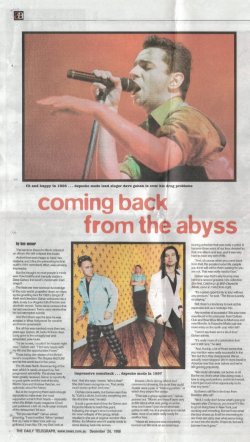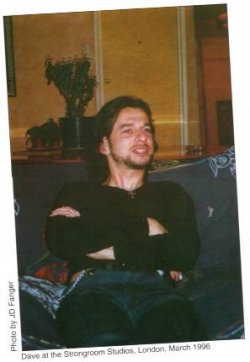Coming Back From The Abyss
[Australian Daily Telegraph, 24th December 1998. Words: Ben Wener. Picture: Anton Corbijn / Uncredited.]

The last time Depeche Mode released an album, the talk eclipsed the music.
Ardent fans were happy to have new material, and Ultra, the pioneering techno outfit’s 1997 comeback effort, was certainly impressive.
But the thought on most people’s minds was: how healthy and mentally stable is Dave Gahan, the band’s charismatic lead singer?
The facts are now common knowledge in the rock world: propelled down an abyss by the gruelling tour for 1993’s Songs Of Faith And Devotion, Gahan withdrew into a dark, lonely Los Angeles full of heroin and alcoholic excess. Twice came rumours that he had overdosed. Twice came stories that he had attempted suicide.
And then there was the time he was arrested in West Hollywood for cocaine and heroin possession.
But all this was resolved more than two years ago. Gahan, 36, looks fit these days. Long gone is the scraggly hair and emaciated, pale looks.
“To be honest, I couldn’t be happier right now.” Gahan said. “I feel very happy with my life and the opportunities I have.”
These being the release of the British band’s compilation The Singles 86>98 and its first world tour in five years.
The 35-date North American leg of the tour, which is nearly wrapped up, has progressed splendidly. The shows have been greatly received, Gahan is reportedly in good spirits and the rest of the trio, Martin Gore and Andrew Fletcher, are optimistic about the future.
But at the beginning there were enough signposts to make even the most supportive scratch their heads – especially when the British music magazine Q had just published a tell-all, multi-page account of the debauched ’93 tour.
“Did you see that?” Gahan asked, groaning. “I was horrified. When I picked that up, I was in New York with my girlfriend. I was like, ‘Oh, my God, look at that’. And she says, I swear, ‘Who’s that?’. She didn’t even recognise me. That pretty much sums up then and now.” [1]
Cliches come easily, but Gahan says they fit. “Call it a cliché, but I take everything one day at a time now,” he said.
It took a great deal of time for Gahan and Depeche Mode to reach this point. Following the singer’s time in rehab and the near-collapse of the group, which resulted in the exit of original member Alan Wilder, the Moders weren’t exactly ready to come blazing back into arenas.
Despite Ultra’s strong critical and commercial showing, the most they could muster were a pair of “listening parties”, at which they played five songs.
“That was a group agreement”, Gahan pointed out. “Martin and myself were very public about what was going on at the time, but it wasn’t just about what was going on with me. In a physical and mental state, none of us were really ready for another tour.
“Above all, everyone was completely burned out. We took on an enormous touring schedule that was really a grind. It became three years of our lives devoted to that one album and tour, and it was very hard to have any sort of life.
“And of course, when you come back from that, the people in your life, people you think will still be there waiting for you, are not. That was really hard to face.”
Gahan says that’s why touring now, behind a second greatest-hits collection (the first, Catching Up With Depeche Mode, came in 1985) feels right.
“It’s a great opportunity to tour without any pressure,” he said. “The focus is solely on playing.”
Still, there’s a tendency to look at this expensive trek as a nostalgia trip.
Any number of successful ‘80s acts have resurfaced in the past year, from Culture Club and Bow Wow Wow to Madness and now Blondie. Is Depeche Mode just one more entry on the synth-pop retro list?
“I won’t say there isn’t a bit of that,” Gahan admits.
“It’s really more of a celebration that we’re still here,” he said.
“And, frankly, a lot of those bands that you mention were really successful in the ‘80s but then they disappeared. We’ve never actually stopped. We’re more loved in America now than ever before and we’re still gaining popularity.
“We could ultimately not bother at all. But for me, that’s what I like doing most. I love to sing and perform, and to be honest, I don’t get much of an opportunity to do that any more.”
So there’s still life in the boys from Basildon after all?
“Well, I really don’t know what’s going to happen after Christmas, you know? I’d like to go on living here in New York, just working and recording. But we’ll see what this tour shows us. It will be interesting to see if we can carry over what we’re doing on tour in the studio. I hope so, but we’ll just see how it goes.”
[Australian Daily Telegraph, 24th December 1998. Words: Ben Wener. Picture: Anton Corbijn / Uncredited.]
A fairly run-of-the-mill short article, aimed at the general public in a daily newspaper, promoting the Singles Tour and using the opportunity to recap the band's and especially Dave's recent troubles. Perfectly serviceable, but nothing fans won't be familiar with.
" It’s really more of a celebration that we’re still here "
Many thanks to Michael Rose for kindly supplying a scan of this article.

The last time Depeche Mode released an album, the talk eclipsed the music.
Ardent fans were happy to have new material, and Ultra, the pioneering techno outfit’s 1997 comeback effort, was certainly impressive.
But the thought on most people’s minds was: how healthy and mentally stable is Dave Gahan, the band’s charismatic lead singer?
The facts are now common knowledge in the rock world: propelled down an abyss by the gruelling tour for 1993’s Songs Of Faith And Devotion, Gahan withdrew into a dark, lonely Los Angeles full of heroin and alcoholic excess. Twice came rumours that he had overdosed. Twice came stories that he had attempted suicide.
And then there was the time he was arrested in West Hollywood for cocaine and heroin possession.
But all this was resolved more than two years ago. Gahan, 36, looks fit these days. Long gone is the scraggly hair and emaciated, pale looks.
“To be honest, I couldn’t be happier right now.” Gahan said. “I feel very happy with my life and the opportunities I have.”
These being the release of the British band’s compilation The Singles 86>98 and its first world tour in five years.
The 35-date North American leg of the tour, which is nearly wrapped up, has progressed splendidly. The shows have been greatly received, Gahan is reportedly in good spirits and the rest of the trio, Martin Gore and Andrew Fletcher, are optimistic about the future.
But at the beginning there were enough signposts to make even the most supportive scratch their heads – especially when the British music magazine Q had just published a tell-all, multi-page account of the debauched ’93 tour.
“Did you see that?” Gahan asked, groaning. “I was horrified. When I picked that up, I was in New York with my girlfriend. I was like, ‘Oh, my God, look at that’. And she says, I swear, ‘Who’s that?’. She didn’t even recognise me. That pretty much sums up then and now.” [1]
Cliches come easily, but Gahan says they fit. “Call it a cliché, but I take everything one day at a time now,” he said.
It took a great deal of time for Gahan and Depeche Mode to reach this point. Following the singer’s time in rehab and the near-collapse of the group, which resulted in the exit of original member Alan Wilder, the Moders weren’t exactly ready to come blazing back into arenas.
Despite Ultra’s strong critical and commercial showing, the most they could muster were a pair of “listening parties”, at which they played five songs.
“That was a group agreement”, Gahan pointed out. “Martin and myself were very public about what was going on at the time, but it wasn’t just about what was going on with me. In a physical and mental state, none of us were really ready for another tour.
“Above all, everyone was completely burned out. We took on an enormous touring schedule that was really a grind. It became three years of our lives devoted to that one album and tour, and it was very hard to have any sort of life.
“And of course, when you come back from that, the people in your life, people you think will still be there waiting for you, are not. That was really hard to face.”
Gahan says that’s why touring now, behind a second greatest-hits collection (the first, Catching Up With Depeche Mode, came in 1985) feels right.
“It’s a great opportunity to tour without any pressure,” he said. “The focus is solely on playing.”
Still, there’s a tendency to look at this expensive trek as a nostalgia trip.
Any number of successful ‘80s acts have resurfaced in the past year, from Culture Club and Bow Wow Wow to Madness and now Blondie. Is Depeche Mode just one more entry on the synth-pop retro list?
“I won’t say there isn’t a bit of that,” Gahan admits.
“It’s really more of a celebration that we’re still here,” he said.
“And, frankly, a lot of those bands that you mention were really successful in the ‘80s but then they disappeared. We’ve never actually stopped. We’re more loved in America now than ever before and we’re still gaining popularity.
“We could ultimately not bother at all. But for me, that’s what I like doing most. I love to sing and perform, and to be honest, I don’t get much of an opportunity to do that any more.”
So there’s still life in the boys from Basildon after all?
“Well, I really don’t know what’s going to happen after Christmas, you know? I’d like to go on living here in New York, just working and recording. But we’ll see what this tour shows us. It will be interesting to see if we can carry over what we’re doing on tour in the studio. I hope so, but we’ll just see how it goes.”
[1] - I would imagine that is the March 1997 edition of Q, which ran an in-depth, three-part feature. Although Dave does have some nasty bags under his eyes in many of the photos, he doesn't look that bad; if those pictures threw his girlfriend, I hate to think what she'd have made of this picture in a Bong magazine a year earlier.

